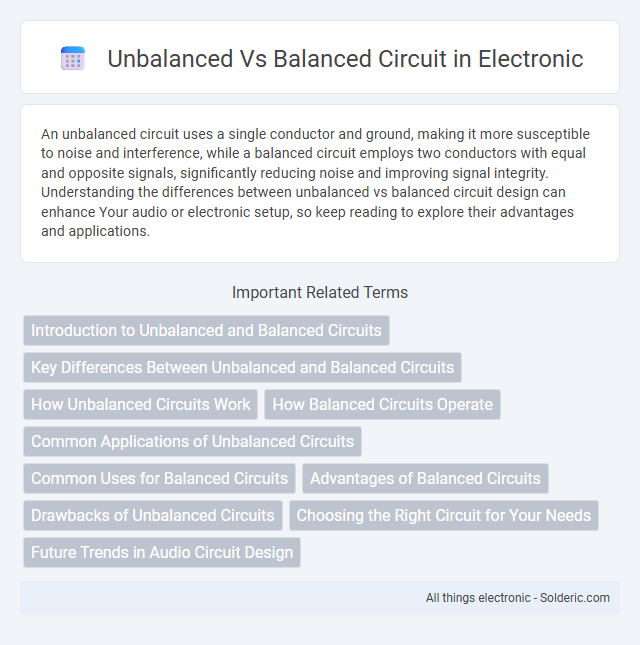An unbalanced circuit uses a single conductor and ground, making it more susceptible to noise and interference, while a balanced circuit employs two conductors with equal and opposite signals, significantly reducing noise and improving signal integrity. Understanding the differences between unbalanced vs balanced circuit design can enhance Your audio or electronic setup, so keep reading to explore their advantages and applications.
Comparison Table
| Feature | Unbalanced Circuit | Balanced Circuit |
|---|---|---|
| Signal Conductors | Single conductor + ground | Two conductors with equal impedance + ground |
| Noise Immunity | Low, susceptible to interference | High, rejects common-mode noise |
| Typical Usage | Consumer audio, unshielded connectors | Professional audio, studio and broadcast |
| Cable Type | Coaxial, TS cables | Twisted pair, XLR cables |
| Cost | Lower cost | Higher cost |
| Signal Transmission Distance | Short distances (up to ~10m) | Long distances (100m+) |
| Connector Types | TS, RCA | XLR, TRS |
Introduction to Unbalanced and Balanced Circuits
Unbalanced circuits use a single conductor and ground reference, making them more susceptible to noise and signal interference, commonly found in consumer audio and single-ended devices. Balanced circuits employ two conductors with equal impedance to ground, offering superior noise rejection by canceling out interference, widely utilized in professional audio and telecommunications. Understanding the differences between unbalanced and balanced circuits is crucial for optimizing signal integrity and reducing electromagnetic interference in electronic system design.
Key Differences Between Unbalanced and Balanced Circuits
Unbalanced circuits use a single conductor and ground as a return path, making them more susceptible to noise and interference compared to balanced circuits, which utilize two conductors with equal impedance to ground that carry signals in opposite phases to cancel noise. Balanced circuits offer superior noise rejection and signal integrity, particularly beneficial in audio and communication applications, while unbalanced circuits are simpler and cost-effective for short-distance connections. The impedance symmetry in balanced circuits ensures reduced electromagnetic interference and signal degradation, distinguishing them from the asymmetrical design of unbalanced circuits.
How Unbalanced Circuits Work
Unbalanced circuits operate by having one conductor carry the signal while the other is connected to ground, making them more susceptible to noise and electromagnetic interference. Common in consumer audio and low-frequency applications, unbalanced circuits use a single-ended approach where the reference ground helps complete the circuit. This design simplicity reduces cost but limits signal integrity over long distances compared to balanced circuits.
How Balanced Circuits Operate
Balanced circuits operate by using two conductors carrying equal and opposite signals, which helps to cancel out electromagnetic interference and noise. This differential signal transmission ensures higher signal integrity and reduced susceptibility to external disturbances compared to unbalanced circuits. Your audio or data transmission benefits from cleaner signals and improved noise rejection when using balanced circuits.
Common Applications of Unbalanced Circuits
Unbalanced circuits are commonly used in consumer audio equipment, such as headphones, guitars, and home stereo systems, due to their simplicity and cost-effectiveness. These circuits rely on a single signal conductor and a ground reference, making them more susceptible to noise and interference over long cable runs. Despite this limitation, unbalanced circuits remain popular for short-distance audio connections where budget and convenience are primary concerns.
Common Uses for Balanced Circuits
Balanced circuits are commonly used in professional audio and telecommunications to reduce noise and interference over long cable runs, ensuring clear signal transmission. Your audio equipment benefits from balanced connections when using XLR or TRS cables, which maintain signal integrity by carrying equal and opposite signals that cancel out external noise. This design is essential in studios, live sound environments, and broadcast setups where signal clarity is critical.
Advantages of Balanced Circuits
Balanced circuits offer superior noise rejection by utilizing differential signaling, which significantly reduces electromagnetic interference and crosstalk. They enhance signal integrity over long cable runs, making them ideal for professional audio, telecommunications, and data transmission applications. Additionally, balanced circuits provide consistent impedance matching, minimizing signal reflections and ensuring high-quality performance.
Drawbacks of Unbalanced Circuits
Unbalanced circuits often suffer from increased susceptibility to electromagnetic interference and noise, resulting in degraded signal quality and reduced performance, especially over long cable runs. They typically exhibit lower common-mode noise rejection compared to balanced circuits, making them less reliable in professional audio and sensitive electronic applications. Unbalanced connections also tend to introduce ground loop issues, which can manifest as hum or buzz in audio systems.
Choosing the Right Circuit for Your Needs
Choosing the right circuit depends on the specific application requirements and interference levels. Balanced circuits offer superior noise rejection and are ideal for long cable runs in professional audio or sensitive instrumentation. Unbalanced circuits are simpler and more cost-effective for short distances and less interference-prone environments, making them suitable for basic consumer electronics.
Future Trends in Audio Circuit Design
Future trends in audio circuit design emphasize the shift towards balanced circuits due to their superior noise rejection and improved signal integrity, especially in professional audio environments. Advances in integrated circuit technology and digital signal processing enable more compact balanced designs with lower distortion and enhanced dynamic range. Unbalanced circuits remain prevalent in consumer applications, but evolving requirements for higher fidelity and interference resistance drive innovation favoring balanced architectures.
unbalanced vs balanced circuit Infographic

 solderic.com
solderic.com